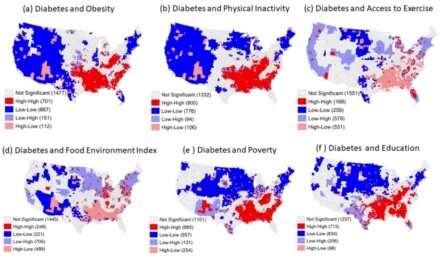AI tool can spot Type 2 diabetes trends in the U.S.

A new University at Buffalo study reports on the advantages of using artificial intelligence to better understand Type 2 diabetes across the United States.
The study describes how machine learning—a subset of AI that involves computers acting intelligently without being explicitly programmed—can help explore the prevalence of the disease, which effects more than 34 million Americans, as well as spot future trends.
The work was led by Zia Ahmed, a senior scientist and associate research professor at the UB RENEW Institute. It was published March 26 in Nature's Scientific Reports.
Type 2 diabetes prevalence in the United States varies substantially, Ahmed says, the result of wide-ranging socioeconomic and lifestyle risk factors.
The study drew upon data reported in the Centers for Disease Control and Prevention's (CDC) U.S. Diabetes Surveillance System, and the CDC's Behavioral Risk Factor Surveillance System. Additional data such as how six risk factors—access to higher education, poverty, obesity, physical inactivity, access to exercise areas like public parks, and access to healthy food—came from the U.S. Census Bureau's Population Estimates Program.
The machine learning program the research team employed—a geographically weighted random forest model—outperforms existing methods, Ahmed says.
Better understanding the variations in these risk factors could help with intervention and treatment approaches to reduce or prevent Type 2 diabetes, Ahmed says. He adds the study findings could lead to more tailored and effective prevention strategies from a policy perspective, which is critical given the projected increase of diabetes.
"Zia has comprehensive training, research, and supervisory experience in geospatial data sciences in agricultural, health, and environmental applications. His current research interest is explainable artificial intelligence (XAI) for exploring spatial heterogeneity of local contribution in prediction. His knowledge and skills in advanced data techniques and machine learning are impacting various focus areas of RENEW including environmental exposures, genomes and health," said Amit Goyal, SUNY Distinguished Professor and founding director of UB's RENEW Institute.
Ahmed has more than 20 years of experience in environmental modeling and data analysis. Areas of expertise include data mining; geographic information systems, remote/proximal sensing, and geostatistics; linear/non-linear model, mixed effect model, multivariate statistics and machine learning; and database management.
More information: Sarah Quiñones et al. Geographically weighted machine learning model for untangling spatial heterogeneity of type 2 diabetes mellitus (T2D) prevalence in the USA, Scientific Reports (2021). DOI: 10.1038/s41598-021-85381-5




















